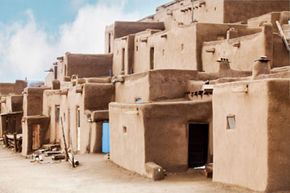Add Water, Then Stir
Adobe construction today follows many of the same principles used since the ninth century B.C. Some brick-makers use variations: They use artificial heat rather than the sun to dry the bricks, or they pour the adobe mixture into larger molds rather than making individual bricks. Others add cement, asphalt or other substances to make the bricks stronger. But bricks that have been dried by fire or that have additives don't have the same appearance and texture as those made in the traditional way.
Here's how adobe bricks are made:
Advertisement
- Sand and clay are mixed with water.
- Straw or grass (and sometimes manure) is usually added. This helps the mud shrink into uniform brick shapes as it dries.
- The mud mixture is put into wooden forms and leveled by hand. You can make them any size or shape you want, but they should be easy to move by hand.
- The bricks are removed from the forms and laid onto a surface in the sun that's covered with straw or grass.
- After they have dried for a few days, the bricks are set on their edges for at least four weeks of air-drying.
Here's the basic method for building with adobe bricks:
- Build your foundation. Adobe houses usually don't have basements. Foundations can be made of stones or other locally available materials.
- Lay the bricks with mortar. Mud works best because it shrinks and swells with the bricks. Cement and similar mortars are too strong and rigid.
- Stack bricks together to make thick walls—10 inches (25.4 centimeters) or more—for strength. This mass helps cool the house summer and warm it in winter. Adobe houses are usually rectangular and rarely more than two stories high.
- Leave openings for doors and windows. There shouldn't be too many, as they will weaken the structure. Use wooden lintels (supports) over openings.
- Choose a roof. Roofs on adobe houses traditionally vary with the location. Many people choose thatched roofs. Often, builders use logs or rough timbers (called vigas) as beams, with sticks laid over and between them under the roofing. Some people use adobe mud as roofing. Today, builders like terra cotta tile, wooden shingles and metal roofing. The roof should be fairly flat but not level since water needs to run off.
- Select a coating. Builders use coatings of mud plaster, whitewash, lime plaster and cement stucco to protect adobe walls.
Adobe may have a long history, but it's positively cutting-edge in some circles. Read on to find out more about modern adobe construction.
